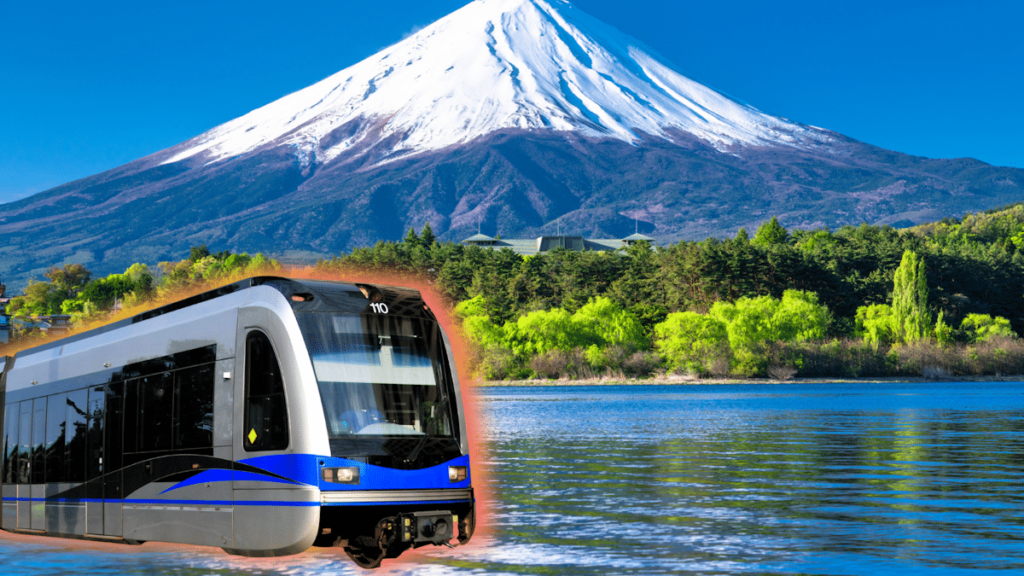[ad_1]
Yamanashi Prefecture’s governor is concerned about overtourism at Mt. Fuji. His plan? Put light rail on the mountain. Sadly for the governor, not everyone’s on board with a plan that critics say will spoil the sacredness of the beloved mountain.
A briefing of skeptics
Thursday this week, Yamanashi Governor Nagasaki Kotaro held the second resident briefing on the prefectural government’s plan. The goal: lay down tracks for a light rail transit (LRT) system on Mt. Fuji. The move is aimed at limiting overtourism, which has riddled the World Heritage Site since its designation by UNESCO a decade ago.
The briefing took place in Fujiyoshida, the biggest city around the northern base of the mountain. Governor Nagasaki spoke for nearly 45 minutes to about 780 residents including Fujiyoshida Mayor Horiuchi Shigeru, an opposing critic. The LRT is a next-generation tramway whose construction is estimated to cost ¥140 billion ($936 million USD).
Governor Nagasaki said, “[We] share your wishes to protect Mt. Fuji. The LRT is one proposal [to protect Mt. Fuji]. [We] want to receive a lot of feedback and lead the way to the best solution.”
The governor’s comment referred to Mayor Horiuchi’s previous claims that construction would scar the “sacred” mountain, which soars 3,776 meters above sea level.
Mt. Fuji, deified as the fire-breathing mountain deity Asama-no-Okami (浅間大神), has been an object of religious worship for centuries, according to the Fujisan World Cultural Heritage Council.
Mayor and locals: build cheap, eco-friendly electric buses

At Thursday’s briefing, Mayor Horiuchi championed expanding the current Fuji Subaru Line’s electric bus system instead. Buses run between Mt. Fuji’s base and fifth station, a popular sightseeing spot 2,300 meters above sea level, for a roundtrip fare of ¥2,800.
Advertisements
“Equipping Mt. Fuji’s fifth station with electric power should be the priority. That would bring promising results for the environment and is feasible with a budget of about ¥500 billion ($33 million USD), or 4% of the LRT plan,” said Mayor Horiuchi at a city assembly in September.
In November 23rd’s resident briefing, he sat back as residents echoed his views opting for more electric buses and traffic regulations on private cars. This, they say, would kill two birds with one stone: control visitor numbers according to buses’ capacity and reduce vehicle exhaust emissions.
“Why doesn’t [the prefectural government] explore the possibility of [more] electric buses?” asked one attendee.
Currently, the Fuji Subaru Line denies entry to private vehicles during the climbing season between mid-July and mid-September. During this time, it operates an electric shuttle bus system with over twenty roundtrips a day throughout the week.
Other skeptical residents said the LRT’s fare, ¥10,000 for a roundtrip, was too expensive.
Prefecture pushing forward
Despite local pushback, Governor Nagasaki has pushed on since first pledging to build the LRT railway up Mt. Fuji during an election campaign in January 2019.
Following a successful election, Governor Nagasaki’s prefectural government released the LRT plan in February 2021. The plan aims for the construction of a 25 to 28-kilometer railway along the Fuji Subaru Line. It would run through the municipalities of Fujikawaguchiko, Fujiyoshida, and Narusawa in ascending order from the mountain’s foot to its fifth station.
The capacity of one LRT train is set for 120 passengers traveling 52 minutes uphill and 74 minutes downhill.
Some say it’s counterproductive
Some experts say the LRT may not even help the problem it aims to solve.
“[The railway] may exacerbate Mt. Fuij’s overtourism,” says Hosei University economics professor Murakushi Nisaburo.
The professor points out that snowfall on the Fuji Subaru Line may have deterred tourists from venturing out to Mt. Fuji in the winter. But opening a railroad will invite even more tourists than there currently are.
This may threaten the mountain’s status as a World Heritage Site. The International Council on Monuments and Sites (ICOMOS) has already called for “visitor management,” such as reducing the number of hikers.
ICOMOS has warned that if Mt. Fuiji’s congestion issues are not resolved the site will be added to the Heritage Alert List. That increases the risk that Fuji could lose its World Heritage status.
Sources
[1] 富士山LRT構想を山梨知事熱弁、反対する市長は発言せず…「往復一万円」に住民からも疑問の声. 読売新聞オンライン
[2] Yamanashi pushing railway plan on Mt. Fuji, but city opposes. The Asahi Shimbun
[3] 「富士山登山鉄道構想」山梨県が住民に初の説明会 山中湖村. NHK
[4] 富士山の「登山鉄道」構想が再び浮上 オーバーツーリズム対策というけど…環境保全の実効性は?. 東京新聞
[5] 富士山を登るには「往復1万円の負担」を計画中…山梨県を二分する「富士スバルライン廃止」の是非. PRESIDENT Online
[ad_2]
Source link



